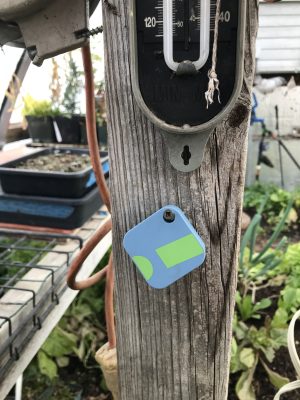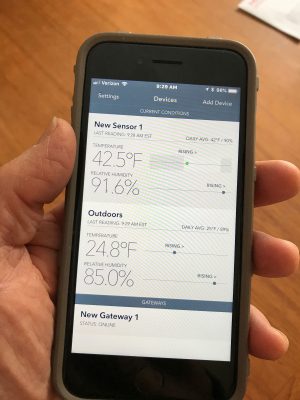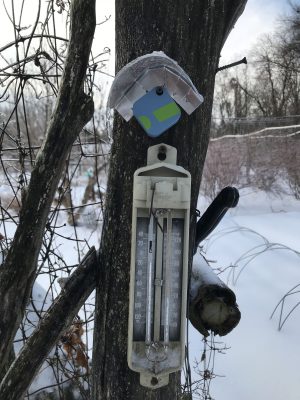Fahrenheit Obsession
A Pillbox Relaxes Me
A little blue pillbox has solved my sleep problems.
I’ve touted the abundance of fresh figs I gather in summer and fall from my greenhouse, and the salad greens in winter. Not to mention the transplants for the garden in spring and summer.
All this has come at a price: sleep. In winter I often worry that something will go awry with the heater that keeps greenhouse temperatures from dropping below freezing, threatening the life of the in-ground fig trees and the salad greens.
And things have occasionally gone awry. One winter, the gas company didn’t deliver the gas for the propane heater on time. Another winter the pilot light kept going out on the heater. Another winter there was an interruption in electrical service, just a small amount of which is needed for the thermostat.
From the warmth of my home, how could I know if my plants were suffering so that I could take action? I set up a remote monitor with a secondary thermostat and a light bulb; if the greenhouse temperature drops below 35° F., I know it because the light goes on. Of course, I have to look outside at the greenhouse occasionally. And if I’m in bed on some cold winter night . . . a bicycle mirror mounted on the window lets me know if the light is on without my even having to lift my head. Of course, all bets if I am asleep, or if electrical service is interrupted.
Which brings me back to the blue pillbox. It’s filled with electronics, not pills.

SensorPush in greenhouse
This device, sold as SensorPush, hangs on a nail in my greenhouse and continuously records temperature and humidity therein. No need for me to go to the greenhouse to communicate with it, though. It beams the information via bluetooth to my smartphone.
Better still, I can retrieve the information if my phone is beyond the approximately 325 foot bluetooth range with the help of the SensorPush Gateway. The Gateway connects via wi-fi to put the temperature and humidity information on the web and then on to my smartphone. From anywhere that I have cell service.
The Gateway connects via wi-fi to put the temperature and humidity information on the web and then on to my smartphone. From anywhere that I have cell service.
And even better, SensorPush can also alert my smartphone (and, hence, me) should the greenhouse temperature ever drop below (or above) whatever low (or high point) I set it at. The Gateway does require electricity. But Central Hudson has an alert feature to notify me, again via my increasingly smart smartphone, if the electrical service has been interrupted.
Checking Out the Weather, Continuously
I’m going to get another SensorPush to hang outdoors on one of the garden fenceposts. Knowing temperatures and humidity out in the garden is very useful to anyone who grows tree fruits.
Spring frosts threaten blossoms of fruit trees that bloom early in the season. Most threatened are apricots and peaches, but a season’s crop of apples, pears, cherries, or plums could also be snuffed out by a dramatic drop temperature.  Just how much cold kills these blossoms depends on the kind of fruit and the stage of blossoming. For instance, when apricot flower buds have just begun to swell and separate, they’ll laugh off cold down to zero degrees F. Once the petals begin to spread, the buds are killed at 19°F. When petals fall, 24° is lethal.
Just how much cold kills these blossoms depends on the kind of fruit and the stage of blossoming. For instance, when apricot flower buds have just begun to swell and separate, they’ll laugh off cold down to zero degrees F. Once the petals begin to spread, the buds are killed at 19°F. When petals fall, 24° is lethal.
So a SensorPush out in the garden would at the very least tell me whether to expect a crop from any of these tree fruits. Or to take action, like running outside to drape a blanket over a tree.
Knowing temperature and humidity can also predict the likelihood of disease. The spores of brown rot disease of plums, for instance, grow best in rainy weather with temperatures in the mid-70s during bloom or as fruit is ripening. Longer periods of wetness are needed at lower temperatures. Once again, such information can be used for prediction or action, in the latter case a preventative spray of sulfur, for example. (Sulfur, a naturally mined mineral, is an organically approved fungicide.)
A final nice feature of SensorPush is that it keeps records of the data it collects. The graphs it generates can be viewed on my smartphone or downloaded to a computer.
Now . . . if only I had an expensive art collection, a wine cellar, a reptile cage, or something else that needed close monitoring of temperature and humidity, I could justify another SensorPush.
Okay, now I’m going back to sleep, soundly.


2 weeks ago the weather was wonderful. I felt thankful winter was over pulled out hoses scratched about in garden moved some oits etc. Wham. Winter has hit us big time. Never had a foot of snow so late in season… can our gardens adjust to global warming??? Can we??? Hose disaster as frozen solid 8c. Will tender sprouts on hydrangeas survive??? Nightmare out of my hands
One way to avoid disster is to do things according to the calendar, along with an eye on the weather. So every year, here, at least, I plant peas on April 1st. On average, that’s a good time. Some years the soil warms up earlier and I could plant earlier. But, on average, that risks subsequent cold damage. Over the long term, spring has been inching earlier and earlier, so I may eventually push that planting date a bit earlier. But not in response to a few days in one year of warm temperatures.
This blog post really made me laugh, because it sounded way too much like me. I love technology and have multiple different remote sensors for inside and outside my house. I know many lament the invention of the smart phone, but as an avid gardener I love it! Not only for monitoring, but also for the ability to listen to my music and podcasts while working outside and the quick ability to look something up that I’m not quite sure about without having to trek to my desktop computer each time. Enjoy your technology!!
As some one who has multiple thermometers both digital and analog scattered around the garden, this is really cool! Can you download the data so you can save a year’s worth of readings over multiple years? It be awesome to have a long term record to track changes in patterns over time due to climate change.
I agree; I like to have these long term records of temperature right at my farmden. I haven’t done it yet but, yes, I believe you can download a year’s word of data. Go to Sensorpush.com and give them a call and they can answer any questions.
For us low tech guys, in what way does the remote monitor, secondary thermostat and light bulb work? Thanks.
It’s just a thermostat plugged into an outlet, with a light bulb wired to it. When the temperature drops below a certain level, circuit is complete and light bulb turns on. I think SensorPush would be easier and lower tech to set up. It takes less than 5 minutes. Of course, it’s not much use if you don’t have a smartphone.
We built a root cellar in our new house. We’ll be designing a cold air inlet. Sounds like the Sensor would be perfect for making adjustments to our system!
Yes. It’s a great product.
I would like to buy a max min analog thermometer with a quality that may not be possible to find in a modern product. Should i look vintage on ebay? What brands? Are they mercury?
My old reliable one is a Taylor min-max with mercury. Some of the newer ones don’t have mercury and should be just as accurate. But if I had to get just one thermometer now, it would be Sensorpush — more expensive but also providing more information and a record of that information, and can be monitored from inside the house or anywhere else in the world with an internet connection.